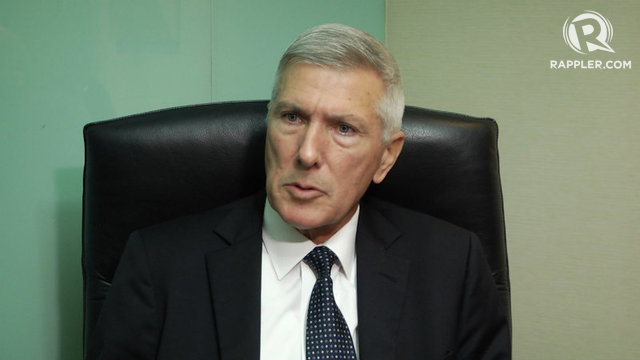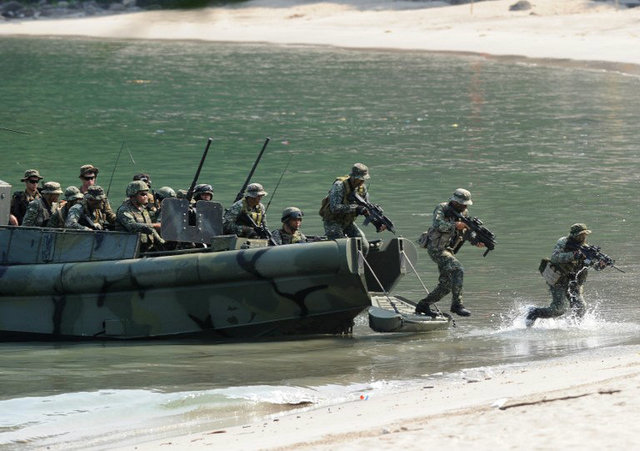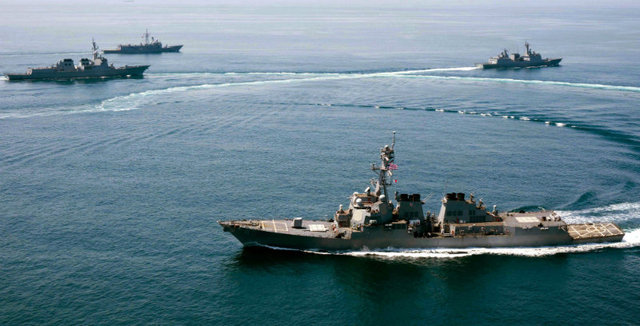Former US Pacific Commander Samuel Locklear says the US will start improving infrastructure in Philippine bases if the Philippine Supreme Court upholds EDCA

IMPROVED INFRASTRUCTURE. Former US Pacific Command Commander Samuel Locklear says the Enhanced Defense Cooperation Agreement will improve infrastructure in Philippine bases. Photo by Franz Lopez/Rappler
The former chief of the US Pacific Command said
the implementation of a Philippine-US military deal will boost Manila China South China Sea
Retired Admiral Samuel Locklear said the deal
known as the Enhanced
Defense Cooperation Agreement (EDCA), coupled with the $79 million in
military funding from the US this year, will focus on boosting Philippine
maritime domain awareness.
The agreement has been pending before the
Philippine Supreme Court for over a year due to questions on its
constitutionality. The Court is set to tackle EDCA on December 16, likely
issuing a ruling.
“Should the people of the Philippines Manila
“You're a country of over 7,000 islands, a huge
archipelago and vast potential EEZs (exclusive economic zones) to have to
police and manage. The Filipino Navy and coast guard have a way to go to
realize the type of capacity they need to be able to defend such a large area
so I think that's primarily where we'd be,” he added.
Signed in
April 2014, the deal gives US troops, ships and planes access to bases of
the Philippine military, one of Asia US
As head of America US
Critics questioned EDCA before the Supreme Court,
arguing that it is a treaty that requires the approval of the Philippine
Senate. Philippine officials said it is a mere executive agreement that builds
on a 1951 treaty with the US
If the high court upholds the deal, Locklear said
the US
“We'll be looking at things that sustain forces
like gas and oil that go into airplanes. We'll be looking at the quality of
runways in different places, the depths of piers and access for ships of
different sizes, and different places around the Philippines
The former top Navy commander said the objective
was to secure equipment for various functions.
“The first thing you would see is the
infrastructure you already have improved to be able to preposition equipment
for multiple uses across multiple contingencies, which means it might be
equally useful in a hurricane response situation as it would be to a land
contingency somewhere in the region. Humanitarian disaster relief is where we'll
probably use it the most.”
The EDCA is part of the Obama administration's
strategic rebalance to Asia after a decade of wars in the Middle
East
Locklear is in Manila think tank Center Asia

'Thank you but it's ours'
The Supreme Court
ruling on EDCA comes as China
builds artificial islands in disputed features in the South China Sea, defying
calls from Manila and Washington
Testifying
before US lawmakers in April, Locklear said China
Even if the EDCA is upheld, CSIS Senior Adviser
Christopher Johnson said China
is unlikely to change its actions in the South China Sea .
“What we're likely to see from them is more argumentation
about how US China
“This
is probably the area where there was the least accommodation or the least
agreement between the two sides, the South China Sea
specifically. The US
When
Obama visited Manila in November, he announced $250 million in military assistance over
two years to develop the maritime capabilities of the Philippines , Vietnam ,
Indonesia and Malaysia Philippines
CSIS
Southeast Asia Deputy Director Murray Hiebert told Rappler that China must weigh its interests in the South China Sea against its rise as an economic
superpower.
“It's up to China China 's
economic rise, how they benefit economically, China South
China Sea , there's a lot of anxiety. So China

CHALLENGING CHINA. The destroyer USS Lassen sailed within 12 nautical miles of Subi Reef in the Spratly archipelago. Locklear says the patrol was meant to show China that its claims on artificial islands in the South China Sea 'can't be accepted.' Photo courtesy: US Navy
'More visible'
As China continues building airstrips and military
installations in disputed waters, the US
Back then, a guided-missile destroyer sailed within the
12-nautical-mile territorial limit China
claims around Subi Reef in the Spratly
Islands
Locklear
explained that China
“We do these all
over. We've operated freely forever in the South China Sea .
The reason this FONOP around the Chinese structures, I think, became so visible
is because these structures didn't exist 36 months ago. They were below the
water most of the time. [It was] the rapid build-up of the islands, the pumping
of the sand, the building of runways.”
The former
commander said it is important for the US
to challenge China
“Because if you
don't disagree with it over time, them being there becomes like common law, it
becomes commonly accepted. To continue the assertion of the Chinese that somehow
they, through the 9-dash line, own all this prompted us to be more visible to
the Chinese than what we already had been doing.”

No comments:
Post a Comment
Note: Only a member of this blog may post a comment.